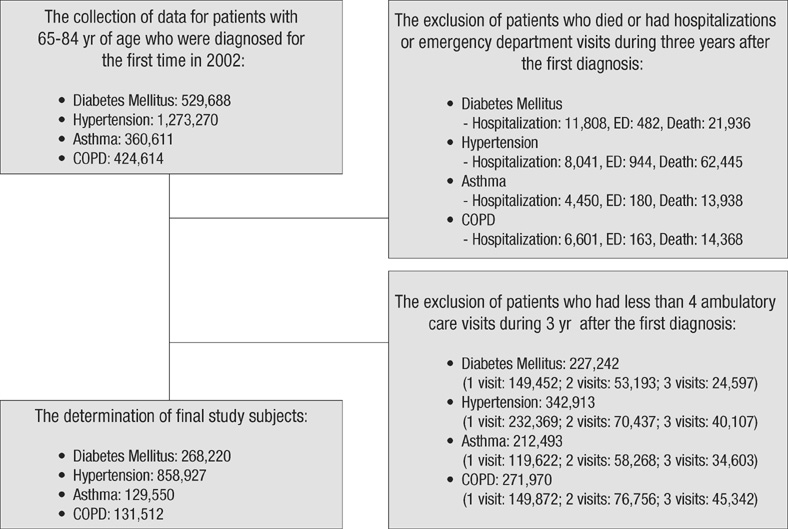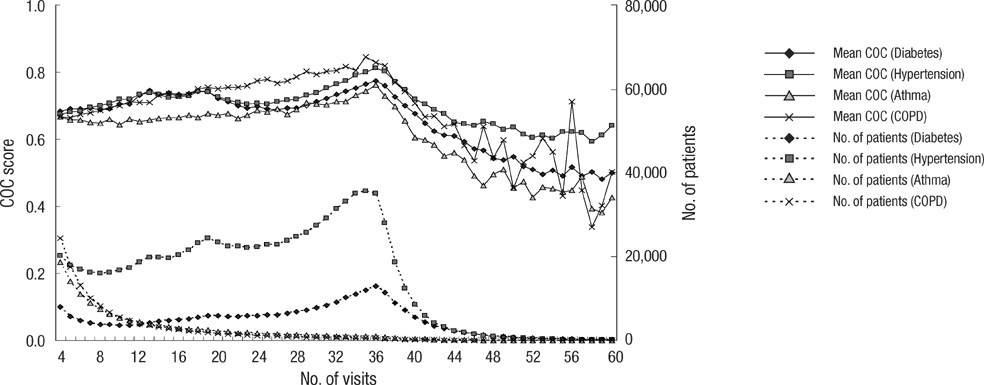J Korean Med Sci.
2010 Sep;25(9):1259-1271. 10.3346/jkms.2010.25.9.1259.
Continuity of Care for Elderly Patients with Diabetes Mellitus, Hypertension, Asthma, and Chronic Obstructive Pulmonary Disease in Korea
- Affiliations
-
- 1Health Insurance Review & Assessment Policy Institute, Health Insurance Review & Assessment Service, Seoul, Korea. dr_hongjs@hanmail.net
- 2Department of Social and Preventive Medicine, Hallym University College of Medicine, Chuncheon, Korea.
- KMID: 1785903
- DOI: http://doi.org/10.3346/jkms.2010.25.9.1259
Abstract
- We sought to assess continuity of care for elderly patients in Korea and to examine any association between continuity of care and health outcomes (hospitalization, emergency department visits, health care costs). This was a retrospective cohort study using the Korea National Health Insurance Claims Database. Elderly people, 65-84 yr of age, who were first diagnosed with diabetes mellitus (n=268,220), hypertension (n=858,927), asthma (n=129,550), or chronic obstructive pulmonary disease (COPD, n=131,512) in 2002 were followed up for four years, until 2006. The mean of the Continuity of Care Index was 0.735 for hypertension, 0.709 for diabetes mellitus, 0.700 for COPD, and 0.663 for asthma. As continuity of care increased, in all four diseases, the risks of hospitalization and emergency department visits decreased, as did health care costs. In the Korean health care system, elderly patients with greater continuity of care with health care providers had lower risks of hospital and emergency department use and lower health care costs. In conclusion, policy makers need to develop and try actively the program to improve the continuity of care in elderly patients with chronic diseases.
Keyword
MeSH Terms
-
Aged
Aged, 80 and over
Asthma/*economics
Cohort Studies
Continuity of Patient Care/*economics
Costs and Cost Analysis
Databases, Factual
Diabetes Mellitus/*economics
Emergency Service, Hospital/economics
Female
Hospitalization/economics
Humans
Hypertension/*economics
Male
National Health Programs
Pulmonary Disease, Chronic Obstructive/*economics
Republic of Korea
Retrospective Studies
Risk
Figure
Cited by 2 articles
-
Establishing a Patient-centered Longitudinal Integrated Clerkship: Early Results from a Single Institution
Ju Whi Kim, Hyunjin Ryu, Jun-Bean Park, Sang Hui Moon, Sun Jung Myung, Wan Beom Park, Jae-Joon Yim, Hyun Bae Yoon
J Korean Med Sci. 2020;35(50):e419. doi: 10.3346/jkms.2020.35.e419.Asthma in the elderly and aging societies in Asia Pacific
Sohei Makino
Asia Pac Allergy. 2012;2(1):1-2. doi: 10.5415/apallergy.2012.2.1.1.
Reference
-
1. Health Care Cost Statistics 2008. Health Insurance Review & Assessment Service. 2008. accessed on 4 Nov 2009. Available at: http://www.hira.or.kr/common/dummy.jsp?pgmid=HIRAF010304010000.2. Raddish M, Horn SD, Sharkey PD. Continuity of care: is it cost effective? Am J Manag Care. 1999. 5:727–734.3. Myers BA. A guide to medical care administration Vol. I: Concepts and principles. 1965. revised ed. Washington, D.C.: American Public Health Association, INC.;32–36.4. Starfield B. Primary Care: Balancing Health Needs, Services, and Technology. 1998. New York: Oxford University Press;286.5. Choi YJ, Kang SH, Kim YI. Association of higher continuity of primary care with lower risk of hospitalization among child and adolescent patients. Korean J Health Policy Adm. 2008. 18:85–107.6. Gill JM, Mainous AG 3rd, Diamond JJ, Lenhard MJ. Impact of provider continuity on quality of care for persons with diabetes mellitus. Ann Fam Med. 2003. 1:162–170.
Article7. Gill JM, Mainous AG 3rd. The role of provider continuity in preventing hospitalizations. Arch Fam Med. 1998. 7:352–357.
Article8. Christakis DA, Mell L, Koepsell TD, Zimmerman FJ, Connell FA. Association of lower continuity of care with greater risk of emergency department use and hospitalization in children. Pediatrics. 2001. 107:524–529.
Article9. Weiss LJ, Blustein J. Faithful patients: the effect of long-term physician-patient relationships on the costs and use of health care by older Americans. Am J Public Health. 1996. 86:1742–1747.
Article10. Worrall G, Knight J. Continuity of care for older patients in family practice: how important is it? Can Fam Physician. 2006. 52:754–755.11. National Health Insurance Corporation. National Health Insurance Program of Korea. 2007. Seoul: Health Care Delivery System;25.12. Health Insurance Index 2007. Health Insurance Review & Assessment Service. accessed on 15 May 2007. Available at: http://www.hira.or.kr/ICSFiles/afieldfile/2008/03/04/DATA_2007.xls.13. Shi L, Samuels ME, Pease M, Bailey WP, Corley EH. Patient characteristics associated with hospitalizations for ambulatory care sensitive conditions in South Carolina. South Med J. 1999. 92:989–998.
Article14. Guidelines of Application for Health Care Cost Reimbursement - Review Application, Statement Form, and Completion Instructions. Health Insurance Review & Assessment Service. 2009.15. Bice TW, Boxerman SB. A quantitative measure of continuity of care. Med Care. 1977. 15:347–349.
Article16. Saultz JW. Defining and measuring interpersonal continuity of care. Ann Fam Med. 2003. 1:134–143.
Article17. Kim J, Kim H, Kim H, Min KW, Park SW, Park IB, Park JH, Baik SH, Son HS, Ahn CW, Oh JY, Lee S, Lee J, Chung CH, Choi KM, Choi I, Kim DJ. Current status of the continuity of ambulatory diabetes care and its impact on health outcomes and medical cost in Korea using National Health Insurance Database. J Korean Diabetes Assoc. 2006. 30:377–387.
Article18. Chobanian AV, Bakris GL, Black HR, Cushman WC, Green LA, Izzo JL Jr, Jones DW, Materson BJ, Oparil S, Wright JT Jr, Roccella EJ. National Heart, Lung, and Blood Institute Joint National Committee on Prevention, Detection, Evaluation, and Treatment of High Blood Pressure. National High Blood Pressure Education Program Coordinating Committee. The Seventh Report of the Joint National Committee on Prevention, Detection, Evaluation, and Treatment of High Blood Pressure the JNC 7 report. JAMA. 2003. 289:2560–2572.
Article19. Thomas SD, Whitman S. Asthma hospitalizations and mortality in Chicago: an epidemiologic overview. Chest. 1999. 116:4 Suppl 1. 135S–141S.20. Holguin F, Folch E, Redd SC, Mannino DM. Comorbidity and mortality in COPD-related hospitalizations in the United States, 1979 to 2001. Chest. 2005. 128:2005–2011.
Article21. Magill MK, Senf J. A new method for measuring continuity of care in family practice residencies. J Fam Pract. 1987. 24:165–168.22. Patten RC, Friberg R. Measuring continuity of care in a family practice residency program. J Fam Pract. 1980. 11:67–71.23. Sloane P, Egelhoff C. The relationship of continuity of care to age, sex, and race. J Fam Pract. 1983. 16:402404–405.24. Fleming MF, Bentz EJ, Shahady EJ, Abrantes A, Bolick C. Effect of case mix on provider continuity. J Fam Pract. 1986. 23:137–140.25. Godkin MA, Rice CA. Relationship of physician continuity to type of health problems in primary care. J Fam Pract. 1981. 12:99–102.26. Hong JS, Kang HC, Kim J. Continuity of ambulatory care among adult patients with type 2 diabetes and its associated factors in Korea. Korean J Health Policy Adm. 2009. 19:51–70.
Article27. Yoon CH, Lee SJ, Choo S, Moon OR, Park JH. Continuity of care of patient with diabetes and its affecting factors in Korea. J Prev Med Public Health. 2007. 40:51–58.
Article28. Kim J. Diabetes in Korea 2007. 2007. Seoul: Health Insurance Review & Assessment Service, Korean Diabetes Association.29. Sokol MC, McGuigan KA, Verbrugge RR, Epstein RS. Impact of medication adherence on hospitalization risk and healthcare cost. Med Care. 2005. 43:521–530.
Article
- Full Text Links
- Actions
-
Cited
- CITED
-
- Close
- Share
- Similar articles
-
- Preoperative management of chronic disease
- Elderly asthma
- Helicobacter pylori Infection Associated with Pulmonary Disease
- Desaturaton due to Acute Exacerbation of Chronic Obstructive Pulmonary Disease in the Patient Who Underwent the Cephalic Vein Bypass Surgery under Epidural Anesthesia
- Asthma in the elderly



